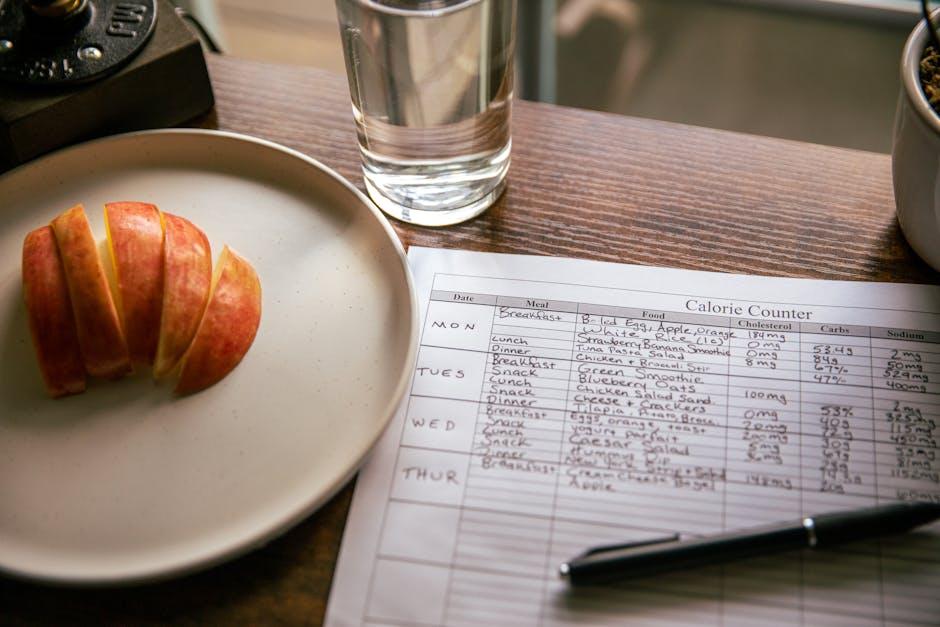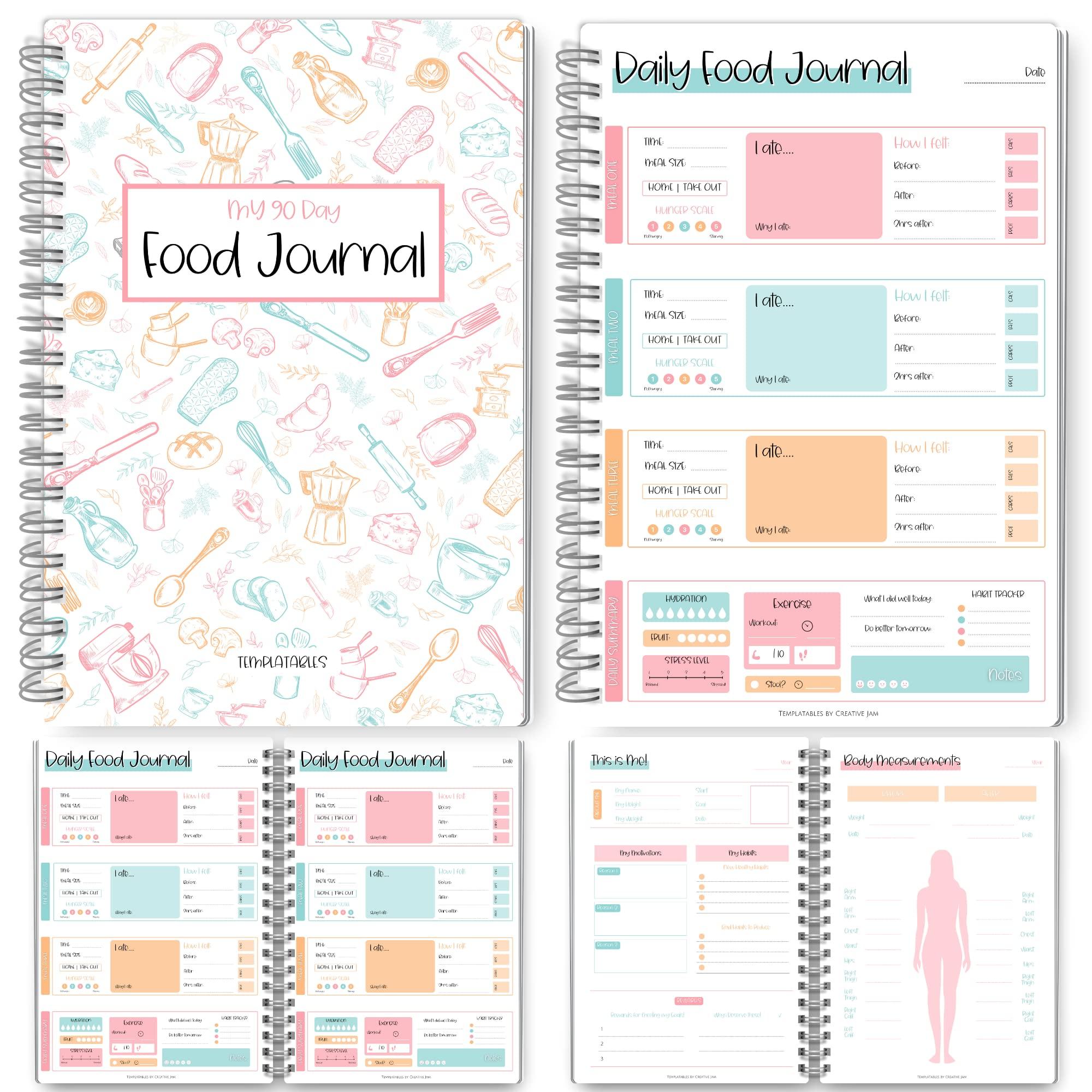Table of Contents
- Understanding the Importance of a Food Journal for Healthy Eating
- How to Start a Food Journal: Essential Tips and Best Practices
- Creating a Balanced Food Journal: What to Include for Optimal Tracking
- The Psychological Benefits of Keeping a Food Journal
- Common Mistakes to Avoid When Maintaining a Food Journal
- Q&A
- Insights and Conclusions


Understanding the Importance of a Food Journal for Healthy Eating
Maintaining a food journal serves as a powerful tool in cultivating a healthier relationship with food. By documenting daily meals, snacks, and beverages, individuals become more aware of their eating habits. This mindfulness encourages them to reflect on their food choices, helping to identify patterns related to emotional eating, cravings, and nutritional gaps. The process of writing down everything consumed holds a mirror to one’s diet, fostering accountability and self-awareness, which are essential for meaningful lifestyle changes.
Another crucial benefit of keeping a food journal is its ability to track progress over time. Individuals can easily spot their achievements and areas needing improvement. This not only assists in setting realistic goals but also provides motivation to stay on course. Here are some specific advantages of this practice:
- Identifying Triggers: Recognizing factors that influence unhealthy choices.
- Caloric Awareness: Understanding daily caloric intake versus expenditure.
- Nutritional Balance: Ensuring an adequate mix of macronutrients.
Moreover, food journals can serve as a communication tool for those working with healthcare professionals or nutritionists. Sharing a food diary allows practitioners to offer personalized advice based on accurate data. It facilitates discussions centered around dietary adjustments, such as improving fiber intake or reducing added sugars. Below is a simple table illustrating common food groups and their recommended servings:
| Food Group | Recommended Daily Servings |
|---|---|
| Fruits | 2-3 servings |
| Vegetables | 3-5 servings |
| Grains | 6-8 servings |
| Protein | 2-3 servings |


How to Start a Food Journal: Essential Tips and Best Practices
Starting a food journal can be a transformative experience, helping you gain insight into your eating habits and overall health. Begin by choosing the right format for your journal. You can opt for a traditional notebook, a digital app, or even a spreadsheet. Here are some things to consider when selecting your medium:
- Portability: Will you carry it with you or access it on the go?
- Ease of Use: Is it simple enough for daily entries?
- Features: Does it allow for tracking supplements, mood, and exercise alongside food?
After you’ve settled on a format, establish a consistent routine for recording your meals. Aim to log your food shortly after eating. This promotes accuracy in your entries. Additionally, you might want to incorporate the following elements into each entry:
- Date and Time: Helps track patterns over time.
- Food Items: Be specific with names, quantities, and cooking methods.
- Feelings: Note your emotional state before and after eating.
Consider also setting specific goals that can direct your journaling efforts. Whether it’s improving nutritional choices, tracking allergies, or managing portion sizes, having a clear purpose will motivate you to stay consistent. You might want to use a simple table format to track your progress over time:
| Date | Food Consumed | Feeling Before | Feeling After |
|---|---|---|---|
| 2023-10-01 | Grilled Chicken Salad | Hungry | Satisfied |
| 2023-10-02 | Pasta Primavera | Bored | Guilty |


Creating a Balanced Food Journal: What to Include for Optimal Tracking
To effectively track your food intake and its impact on your health, your journal should encompass a variety of elements. Begin by documenting macronutrients which include carbohydrates, proteins, and fats. These are essential for understanding your dietary balance. Additionally, integrate micro-nutrients such as vitamins and minerals. This can help you identify any deficiencies or excesses in your diet. Consider using a simple table format to log this information for clarity:
| Food Item | Calories | Carbs (g) | Proteins (g) | Fats (g) |
|---|---|---|---|---|
| Chicken Breast | 165 | 0 | 31 | 3.6 |
| Brown Rice | 216 | 44 | 5 | 1.6 |
| Broccoli | 55 | 11 | 4 | 0.6 |
Incorporating details about your meals is just as important as tracking nutrients. Describe each meal or snack by including the time it was consumed and its portion size. This not only assists in recognizing eating patterns but also makes it easier to identify any triggers related to hunger or cravings. Don’t forget to note how you felt before and after eating; emotions can often influence food choices and portion sizes. Building a comprehensive data set will create a clearer picture of your dietary habits.
Lastly, it’s crucial to keep track of hydration and any additional factors that may affect your food choices. Log your daily water intake, as staying hydrated is vital for overall well-being. If you incorporate exercise into your routine, document the type and duration of workouts. This is part of a balanced lifestyle and can further inform your food choices. A section dedicated to goals can also be incredibly beneficial, allowing you to reflect on what you want to achieve with this journey, whether it’s weight management, improved energy levels, or better overall health.


The Psychological Benefits of Keeping a Food Journal
Keeping a food journal can be an eye-opening experience that goes far beyond tracking calories. By documenting meals, snacks, and even cravings, individuals often gain a deeper understanding of their eating patterns and triggers. This act of writing encourages mindfulness, making it easier to recognize emotional eating or eating out of habit. Over time, this awareness can lead to healthier choices and a more balanced approach to food. Key psychological benefits include:- Enhanced Mindfulness: Writing down what you eat helps create a conscious connection with your food.
- Increased Accountability: Knowing you have to record your meals can deter mindless munching and encourage portion control.
- Emotional Clarity: Reflecting on your food intake allows you to identify mood-related eating, paving the way for healthier coping strategies.
| Positive Effects | Examples |
|---|---|
| Increased Self-Reflection | Identifying emotional triggers for snacking |
| Goal Setting | Tracking daily vegetable intake |
| Behavior Modification | Reducing late-night eating habits |


Common Mistakes to Avoid When Maintaining a Food Journal
Keeping a food journal can be a transformative experience, but many individuals stumble into common traps that hinder their progress. One prevalent mistake is inconsistency. Whether it’s skipping days or not recording late-night snacks, irregular entries can give a skewed view of your eating habits. To mitigate this, set aside a specific time daily to log your meals, ensuring you capture everything you consume. Utilizing apps that send reminders can also help keep you accountable and engaged.
Another frequent issue is lack of detail. Simply noting down “salad” doesn’t provide insight into your nutritional intake. It’s essential to specify ingredients and portion sizes. For instance, instead of writing “chicken salad,” detail it as “grilled chicken breast (5 oz), mixed greens, cherry tomatoes (1/2 cup), and balsamic dressing (2 tbsp).” This level of detail can help track calories and macronutrients effectively, assisting in making informed dietary choices.
be cautious of falling into the trap of judgmental recording. Some people feel overwhelmed by guilt when logging less healthy choices, which leads to skipping entries altogether. Embrace your food journey with an open mind. It’s beneficial to track both healthy and indulgent meals as they reflect your real-life habits. Consider adding a section in your journal for reflections, where you can express your thoughts and feelings about your food choices, promoting a more holistic approach to your relationship with food.
Q&A
Q&A: Exploring the Food JournalQ1: What is a food journal? A food journal is a personal record where individuals document what they eat and drink throughout the day. It can include details about portion sizes, ingredients, eating times, and even feelings surrounding meals. The primary purpose of a food journal is to increase awareness about dietary habits, which can promote healthier eating patterns.Q2: Why should I keep a food journal? Keeping a food journal helps you identify patterns in your eating habits, manage your weight, and make healthier food choices. By tracking your meals and snacks, you can pinpoint triggers for overeating or unhealthy cravings and adjust your diet accordingly. Additionally, it can serve as motivation by allowing you to visually see your progress over time.Q3: How do I start a food journal? Starting a food journal is simple! You can choose between a physical notebook, a digital app, or even a spreadsheet. Begin by noting down everything you consume for at least a week. Include details such as portion sizes, the time of day, and how you felt before and after eating. Consistency is key, so make it a routine part of your day.Q4: What should I include in my food journal? Your food journal should include the following elements:- Date and time of each meal or snack
- Food and drink items consumed
- Portion sizes or quantities
- Location of eating (home, restaurant, etc.)
- Mood or feelings before and after eating
- Any physical sensations (hunger levels, cravings)




0 Comments